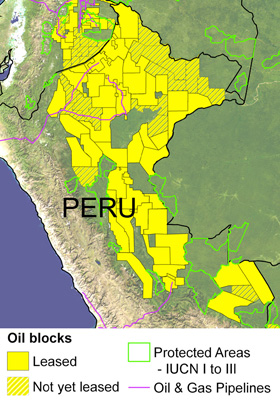More than 70% of the Peruvian Amazon has been allocated for oil and gas extraction, and the current government of Alan Garcia has been pushing for more. Unfortunately, as usual, these policies are promoted by and only benefit a handful of people, but negatively impact the lives of many. However, Garcia’s government did not foresee the potential consequences of their actions.
 Oil and gas blocks in the western Amazon. Solid yellow indicates blocks already leased out to companies. Hashed yellow indicates proposed blocks or blocks still in the negotiation phase. Protected areas shown are those considered strictly protected by the IUCN (categories I to III). Image modified from Finer M, Jenkins CN, Pimm SL, Keane B, Ross C, 2008 Oil and Gas Projects in the Western Amazon: Threats to Wilderness, Biodiversity, and Indigenous Peoples. PLoS ONE 3(8): e2932. doi:10.1371/journal.pone.0002932 |
An excellent paper published in August 2008 by Dr. Matt Finer and collaborators, Oil and gas Projects in the Western Amazon: Threats to Wilderness, biodiversity and Indigenous Peoples, predicted that “environmental and social impacts are likely to intensify without improved policies” regarding the way that Amazonian governments conduct resource extraction. Yesterday, we witnessed the authors’ predictions come true when a number of indigenous civilians and police died as a result of violent clashes over oil and human rights in northern Peru. Indigenous people in Peru have been protesting the Garcia government’s newly created laws that favor and facilitate rapid oil and natural gas extraction in Amazonian Peru. Many of the oil and gas concessions that the government has granted overlap with areas already protected for wildlife and indigenous groups (see Finer et al. 2008 for a detailed account). A number of international news agencies are reporting on this violent conflict, though the victims and perpetrators of the clash change depending on the source. Regardless of exactly who did what, we know that indigenous people of Peru and other Amazonian countries, in addition to the incredible biodiversity of western Amazonia, are facing huge threats on many fronts. The incident that transpired yesterday, on June 5, 2009, is foreshadowing the occurrence of increasingly violent and large-scaled confrontations that will plague all nations as they battle to preserve their own cultures and feed their own mouths, while extracting the Earth’s remaining resources to then sell to the rich.
We urge people to read the cited article and follow the events occurring in Peru and other neighboring countries.
News links regarding the incident in Peru on Friday, June 5, 2009
amazonwatch.org
NYtimes.com
El Mundo (Spain)
AIDESEP
Related articles
Peruvian police kill 22 Indians in battle over Amazon oil drilling
(06/06/2009) At least 30 are dead following a clash between police and Indians protesting oil development in Peru’s Amazon region.
Tribes in Peru to get $0.68/acre for protecting Amazon forest
(06/03/2009) Indigenous communities in Peru will be paid 5 soles ($1.70) per hectare ($0.68/acre) of preserved forest under a new conservation plan proposed by Peru’s Ministry of Environment, reports the International Tropical Timber Organization (ITTO) in its bi-monthly update.
Peru may take military action against Indians protesting Amazon energy development
(05/19/2009) Indigenous protesters have stepped up demonstrations over the Peruvian government’s moves to support energy development in the Amazon rainforest, reports Reuters.
Peru’s uncontacted Amazon tribes under attack
(10/22/2008) Illegal logging in the Peruvian Amazon is driving uncontacted tribes into Brazil where they are in conflict over food and resources with other uncontacted groups, according to a Reuters interview with a leading expert on indigenous tribes.
Indian protesters win land rights battle against Peru’s President Garcia
(08/31/2008) Peru’s Congress rejected two decrees by President Alan García that made it easier for foreign developers to buy Amazon rainforest land. The repeal came just two days after lawmakers struck a deal with indigenous rights groups whose protests over the law had shut down oil and gas operations. The groups were worried that the laws weakened their land rights in favor of loggers, miners, and drillers.
In Peru, a showdown between the president and tribes over mining and drilling in the Amazon
(08/21/2008) In Peru indigenous rights groups and congressional leaders are pairing up against President Alan Garcia to revoke a controversial land law passed last week, reports Reuters.
Oil development could destroy the most biodiverse part of the Amazon
(08/12/2008) 688,000 square kilometers (170 million acres) of the western Amazon is under concession for oil and gas development, according to a new study published in the August 13 edition of the open-access journal PLoS ONE. The results suggest the region, which is considered by scientists to be the most biodiverse on the planet and is home to some of the world’s last uncontacted indigenous groups, is at great risk of environmental degradation.
Peru fails to investigate murder of Amazon environmental leader
(04/22/2008) Peruvian authorities failed to respond to requests for protection from Julio Garcia Agapito, the environmental leader who was gunned down in southeastern Peru in late February, according to a new petition which calls for an investigation into his murder. Julio Garcia’s killing at the hands of an illegal logger set off international outcry and highlighted rising tensions over the paving of a highway in the Amazon rainforest.
Amazon environmentalist gunned down in Peru
(03/14/2008) After reporting a truck loaded with mahogany illegally logged from the Amazon rainforest, Don Julio Garcia Agapito, a Peruvian environmentalist was gunned down by unknown assailants on February 26th, 2008. He is survived by his family.